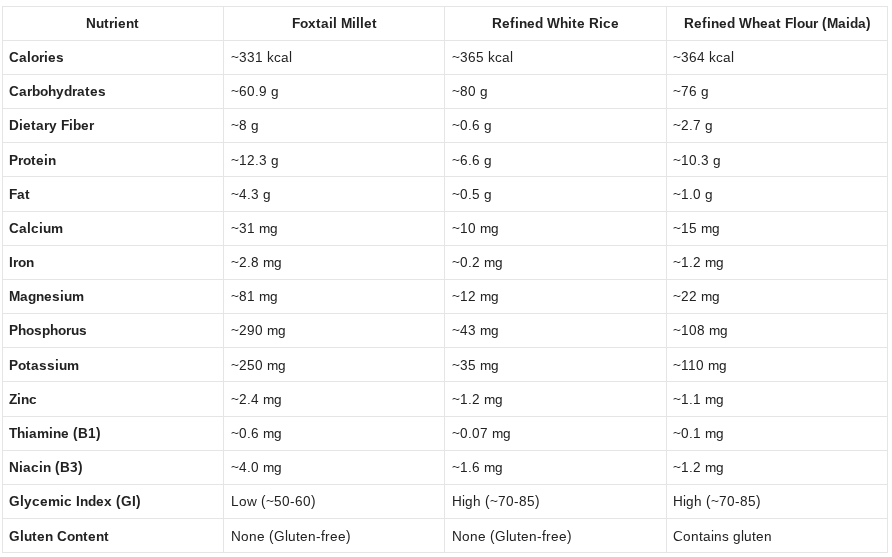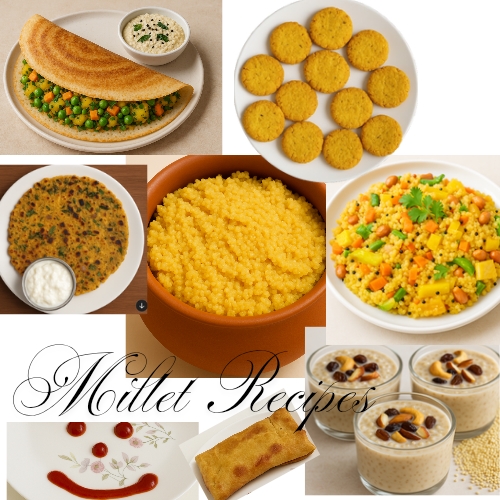We will dive into the incredible health benefits of Foxtail Millet. This foundational guide offers more than just facts — it carries the wisdom and research of the renowned “Millet Man of India”, whose dedication has brought ancient grains back into the spotlight. For those new to millet, take a moment to explore our blog post: What is Millet?
Table of Contents
Why the Name Foxtail?
Foxtail millet is a tiny, golden-hued ancient grain that carries with it the legacy of generations across the world. Its delicate, brush-like panicle gently sways in the wind, resembling the tail of a fox — a poetic touch that gives this grain its name. Loved not only in Asia but also cherished in parts of Europe, it’s fondly called the “Italian grain” due to its cultivation in the serene mountain regions of Italy.
Curious to know how this remarkable grain is named across different cultures and languages? Let’s take a look —

Foxtail Millet Health Benefits
Foxtail millet is a positive grain. As shared by the revered “Millet Man of India,” this title isn’t just a label, but a reflection of its powerful impact on our well-being. With a rich fiber content of 8% and a carbs-to-fiber ratio of less than 10, Foxtail millet stands out as a truly nourishing whole grain. It has the natural ability to cleanse, heal, and rejuvenate the body, offering real hope in reversing lifestyle-related diseases. Find out 10 incredible health benefits of eating foxtail millet as below-
1) Lungs
Foxtail millet can be beneficial for individuals with weak lungs or respiratory conditions such as pneumonia, asthma, bronchitis, and other lung-related issues. It has even been referenced in Indian mythology as a supportive remedy for treating respiratory ailments.
2) Nervous System
Foxtail millet is rich in nutrients like Niacin and Thiamine, which support nerve health and may help in managing neurological disorders such as Autism, Alzheimer’s, Parkinson’s disease, and nerve-related pain. It is also beneficial for age-related conditions like dementia and memory loss. Dr. Khader recommends foxtail millet for pregnant women, as it supports the neurological development of the baby.
3) Blood Sugar
Foxtail millet is high in dietary fiber—about 8%—and has a low glycemic index (GI), making it an excellent choice for individuals with diabetes. It helps regulate blood sugar levels naturally. There are testimonies from patients who have successfully managed their diabetes without medication by including millet in their diet, check the blog post here.
4) Digestion
The high fiber content in foxtail millet promotes regular bowel movements and helps prevent constipation, thereby supporting healthy digestion.
5) Weight Management
Foxtail millet has good fiber and protein content which increases satiety and helps reduce overall calorie intake. It aids digestion & prevents constipation, regular bowel movement also helps in weight management.
6) Gluten-Free
Foxtail millet is ideal for those with celiac disease or gluten intolerance.
7) Nutrient Rich
Foxtail millet is high in dietary fiber, protein, iron, magnesium, and vitamins (especially B-complex).
Contains antioxidants like phenolic acids and flavonoids. For complete list of nutrients see Nutrition.
8) Bone Health
Foxtail millet contains minerals like calcium and phosphorus that are essential for strong bones.
9) Heart Health
Foxtail millet is rich in magnesium and healthy fats, which can help reduce bad cholesterol (LDL) and improve heart function.
Antioxidants also help reduce oxidative stress on the heart.
10) Immunity
Iron and zinc support a healthy immune system and improve oxygen transport.
Nutrition Comparison: Foxtail Millet vs Rice vs Wheat
Here’s a complete health benefits comparison table of Foxtail Millet, Rice (White), and Wheat (Whole) using ✅ (beneficial/present), ⚠️ (moderate/partial), and ❌ (not beneficial/absent) icons.
| Health/Nutrient Parameter | Foxtail Millet | Rice (White) | Wheat (Whole) |
|---|---|---|---|
| Low Glycemic Index | ✅ | ❌ | ⚠️ |
| High in Protein | ✅ | ❌ | ✅ |
| Rich in Dietary Fiber | ✅ | ❌ | ✅ |
| Good Source of Iron | ✅ | ❌ | ⚠️ |
| Good Source of Calcium | ⚠️ | ❌ | ⚠️ |
| Rich in Magnesium | ✅ | ❌ | ✅ |
| Gluten-Free | ✅ | ✅ | ❌ |
| Diabetic-Friendly | ✅ | ❌ | ⚠️ |
| Aids in Weight Loss | ✅ | ❌ | ✅ |
| Heart-Healthy | ✅ | ❌ | ✅ |
| Supports Digestive Health | ✅ | ❌ | ✅ |
| Improves Satiety / Fullness | ✅ | ❌ | ✅ |
💊 B-Vitamin Comparison
| B-Vitamin | Foxtail Millet | Rice (White) | Wheat (Whole) |
|---|---|---|---|
| Thiamine (B₁) | ✅ High | ❌ Low | ✅ Moderate |
| Riboflavin (B₂) | ✅ Moderate | ❌ Very Low | ✅ Moderate |
| Niacin (B₃) | ✅ High | ❌ Low | ✅ High |
Here’s a clear comparison of Foxtail Millet, Refined White Rice, and Refined Wheat Flour (Maida) — all values are approximate per 100 grams (raw):

Key Observations:
- Foxtail Millet is nutrient-dense, high in fiber, gluten-free, and has a low glycemic index.
- Refined White Rice is high in carbs, low in fiber, and most nutrients are stripped during polishing.
- Refined Wheat (Maida) has lower fiber and micronutrients than whole wheat or millet.
Foxtail Millet Health Benefits – Cooking Fermented Porridge (Ambali)
According to the Millet Man of India, eating fermented porridge (Ambali) of Foxtail Millet is most beneficial as it helps reverse lifestyle diseases.
Here is a simple guide on how to cook foxtail millet into fermented porridge (also known as Ambali) for maximum health benefits:
✅ Ingredients:
1 cup foxtail millet (or any millet)
6 cups or more water (adjust depending on millet type and texture preference)
Optional: A pinch of salt or spices
🥣 4 Easy Steps:
1. Rinse and Soak
- Rinse the millet 2–3 times to remove dirt and excess starch.
- Soak in water for 6–8 hours or overnight.
Soaking millet in water for 6-8 hours before cooking is essential for several health and cooking benefits. Here’s why:
Improves Nutrient Absorption
- Millets contain phytates (anti-nutrients) that bind to minerals like iron, zinc, and calcium, making them harder to absorb.
- Soaking helps reduce phytate levels, improving bioavailability of nutrients.
Aids Digestion
- Soaking helps break down complex starches and proteins, making millet easier to digest.
- It can also reduce bloating and gas, especially for people with sensitive stomachs.
Reduces Cooking Time
- Pre-soaked millet cooks faster and more evenly.
- This saves fuel or energy and ensures a better texture.
Lowers Glycemic Impact
- Soaking can slightly reduce the glycemic index by activating enzymes that pre-digest some of the starches, helping in better blood sugar control.
Enhances Flavor and Texture
- Soaked millet often has a softer texture and milder flavor, making it more palatable and versatile in recipes.
2. Cook Millet in Boiling Water
- Take an earthen clay cookware or steel pan
- Put 6 times water and boil the water
- Put soaked millet with water used for soaking
- Let it cook in medium flame/heat till half the water evaporates
- Slow the flame/heat & cover with lid till only little water is left
- Stop the gas/heat & leave it covered with lid for 30 mins till it slightly cools down
3. Ferment
- Cover the earthen ware with cloth, tighten the cloth
- Leave it still in one corner for 4-6 hrs (if its summer season) or 8-12 hrs (if its winter)
- Let it ferment
- Time required for fermentation is same as that of the curd
4. Add Salt/Spices/Vegetables
- After the fermentation is complete, you can add pinch of salt or spices(tadka) or sauted vegetables to make it tasty
🍽️ Tips:
- You can grind the millet before soaking if you want it more watery, this step is optional
- Do not heat it again after fermentation
- Do not add Salt before fermentation, it can be added only after fermentation
- Curd or anything if desired to be added, should be added only post fermentation
If you have any doubts, watch the video on how to make foxtail millet fermented porridge here.
Find 7 delicious foxtail millet recipes here.
Who is the Millet Man of India?
The “Millet Man of India” is Dr. Khader Vali, a food and nutrition scientist renowned for promoting the cultivation and consumption of millets across India, especially traditional varieties like foxtail, little, kodo, barnyard, browntop, and proso millets.
Key Contributions of Dr. Khader Vali:
- Advocates millets as a solution to lifestyle diseases like diabetes, obesity, hypertension, and even certain cancers.
- Promoted the concept of “Siri Dhanya” (positive millets) to differentiate more nutritious millet varieties.
- Encouraged organic farming and natural healing through diet.
- Honored with the Padma Shri award in 2023 for his contribution to health and sustainable agriculture.
Videos
Watch this video in English to hear about Foxtail millet by Dr.Khader Vali, “Millet Man of India”
Watch the video in hindi below.
Conclusion: The Healing Song
In fields of gold beneath the skies,
Foxtail millet softly lies,
A humble grain, yet crowned with grace,
It brings to health a warm embrace.
Not just a seed, but nature’s gift,
That gives the weary soul a lift—
It heals the heart, it calms the flame,
And nourishes with no loud fame.
With every bite, it gently sings
Of ancient roots and healing things.
For blood it steadies, for breath it frees,
A friend to bones, to mind, to knees.
Oh little grain with quiet might,
You turn our darkness into light.
Let modern minds now understand,
The wisdom in your golden strand.
So may we honor what you give,
And choose through you a way to live—
Where health and earth in rhythm meet,
With foxtail’s heartbeat, mild and sweet.
For Tasty Foxtail Millet Recipes click here.


5 thoughts on “Top 10 Powerful Foxtail Millet Health Benefits with Simple Ambali Recipe You Must Try!”